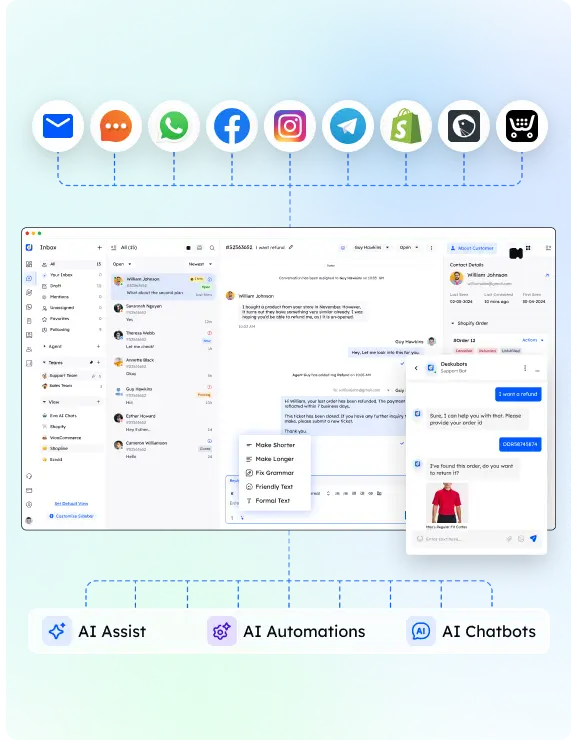If you’re an eCommerce agency looking to make data-backed recommendations for your clients, one of the first questions you’ll ask is: Why Shopify?
The answer is clear: Shopify’s rapid growth, wide market share, and success across millions of stores worldwide make it one of the most trusted platforms in eCommerce today.
In fact, Shopify currently powers over 4.9 million active stores globally – Builtwith, and in 2023 alone, it handled $235.9 billion in Gross Merchandise Volume (GMV)
In this post, we’ll break down 50+ key Shopify statistics to help you understand why agencies and businesses alike are gravitating toward this platform.
50+ Shopify Statistics: Insights into E-Commerce Trends
Shopify Usage Statistics: Global Reach and Market Share
Shopify powers over 4.8 million active websites globally.
28% of all eCommerce sites in the U.S. use Shopify, making it the most popular platform in the country.
Shopify processed $235.9 billion in Gross Merchandise Volume (GMV) in 2023, a 20% increase from the previous year.
Shopify’s market share globally is 10.32%, ranking it as the third largest eCommerce platform after WooCommerce and Wix.
81% of Shopify purchases are made via mobile devices, highlighting its mobile-first design.
Shopify stores generate an average of $5,583 in revenue per month, amounting to about $66,996 annually.
Shopify Plus is used by over 7,000 high-revenue businesses, including big brands like Pepsi, Tesla, and Fashion Nova.
The average conversion rate on Shopify is 1.4%, with top-performing stores reaching above 3.3%.
Shopify merchants have downloaded over 25 million apps from the Shopify App Store.
Shopify’s market cap as of August 2024 is $96.61 billion, a recovery from a drop in 2022.
Shopify has more than 9,200 employees as of 2023, following a 20% reduction earlier that year.
The average order value on Shopify in 2023 was $73.
52% of Shopify merchants are female.
Most Shopify merchants (37.5%) are between the ages of 25-34, reflecting its appeal to younger entrepreneurs.
Shopify supports stores in 175 countries, with only 20 countries where the platform is not available.
Shopify has over 9,700 apps available in its App Store as of 2024, covering everything from marketing to inventory management.
On Black Friday/Cyber Monday 2019, Shopify processed over $2.9 billion in sales, with sales peaking at $1.5 million per minute.
Shopify’s Growth and Financial Performance in 2024
Shopify subscription solutions generated $525 million in Q4 2023, showing a 31% year-over-year growth.
Shopify Payments handles over 60% of Shopify’s GMV, totaling $45.1 billion in Q4 2023.
Shopify is the third-largest online retailer in the U.S., behind Amazon and eBay.
There are over 7,000 Shopify Plus stores globally, used by enterprise-level businesses.
Black Friday/Cyber Monday: Shopify’s Record-Breaking Sales
Shopify’s average sale value during Black Friday/Cyber Monday 2023 was $83 in the U.S., and higher in Canada at $96.
Shopify’s top-selling products worldwide include t-shirts, vitamins, and shoes, although these vary by country.
Shopify has a 17.31% share of the global eCommerce platform market in 2024.
Shopify can be translated into 20 languages, increasing its global accessibility.
Shopify Plus accounts for 31% of Shopify’s monthly recurring revenue, which reached $149 million in Q4 2023.
Over 48,991 websites currently run Shopify Plus, with nearly 20,000 distinct merchants.
Shopify merchants spent over $100 million in the Shopify App Store, with over 12 million apps installed.
The top 10% of Shopify stores generate an average sale revenue of $343, while the bottom 10% average $15 per sale.
Shopify POS (Point of Sale) powers over 100,000 merchants worldwide.
Shopify’s average customer purchases 3.8 times from the same store, indicating strong repeat business.
Shopify Plus allows merchants to add up to 1,000 domains and subdomains, enabling complex multi-site operations.
Shopify merchants generated $446 million in free cash flow in Q4 2023, representing 21% of total revenue.
Shopify merchants processed 300 million orders in 2019, demonstrating the platform’s scale.
Shopify Payments is available in 23 countries, offering seamless payment solutions.
Nearly 70% of Shopify’s top-performing stores use mobile-friendly themes, such as Dawn and Impact.
Shopify’s revenue increased by 24% in Q4 2023, reaching $2.14 billion.
Shopify merchants account for 21% of the world’s top 10,000 eCommerce sites, based on traffic.
Shopify Themes and Design Customization Trends
Shopify’s theme store offers over 160 customizable themes, helping merchants build unique storefronts.
Shopify’s merchant solutions revenue rose by 21.3% in Q4 2023, driven by GMV growth.
Shopify Pay Installments is the third most popular payment method globally, used by 14.6% of merchants.
Shopify merchants saw an 82% increase in online store visits during the COVID-19 pandemic, with nearly 2.6 million new stores created.
Shopify’s GMV increased by 22% YoY in Q2 2024, hitting $67.2 billion.
The average visitor to a Shopify store spends more than three minutes on the site, visiting at least three different stores.
Shopify merchants have installed over 10,000 store design and marketing apps, enhancing customer experiences.
Shopify stores are most common in the U.S., followed by the UK and Australia, with over 1.1 million stores live in the U.S. alone.
The top categories for Shopify stores include apparel (520,321 stores), home and garden (221,381), and beauty and fitness (186,706).
Shopify stores average 2.1 million daily active users, showing the platform’s high engagement.
Shopify Plus begins at $2,000 per month, with additional transaction fees for certain businesses.
The Shopify Plus platform supports up to 38,357 domains, with more growth projected in the coming years.


